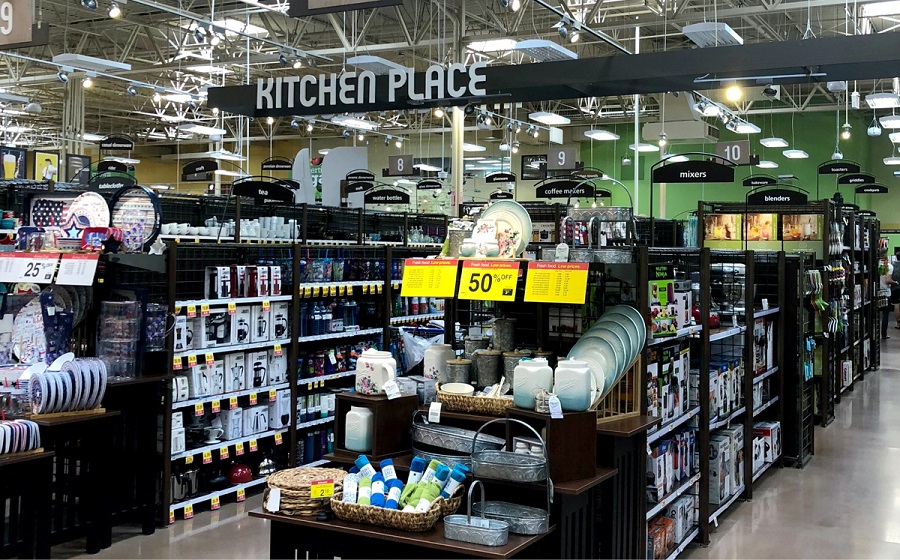Back when Walmart first went into the grocery business, it took some getting used to that you could buy your food at a store previously only known for general merchandise goods. But it obviously succeeded and today Walmart is the largest supermarket chain in the country. Amazon’s entry into the grocery business with its purchase of Whole Foods last year was another case of outsiders moving into the huge business of selling food.
Now Kroger – the store Walmart dispossessed at the top of the food chain — has decided it can play that game too. Over the past few years, Kroger has been slowly but surely rolling out its Marketplace concept stores: grocery stores with dedicated space for kitchenware, as well as soft home fashions and other assorted home furnishings products.
At the end of 2016, Kroger – with about 2,800 stores in 35 states – was operating 153 of what it calls Marketplace stores, incorporating a variety of home merchandise within its grocery footprint. While this only accounted for about five percent of the company’s total store mix, Marketplace stores are considered a major initiative for Kroger. In its most recent company Fact Book, Kroger says, “We expect this format to be one of our primary growth formats of the future.”
The Marketplace format is not to be confused with the broader “Multi-Department Store” division within Kroger, which consists of 132 stores under the Fred Meyer and Smith’s banners featuring full general merchandise assortments including apparel and footwear, in addition to grocery. Kroger differentiates these units from its other stores as: “A multi-department store unlike any other. It’s not a big box store, hypermarket, supercenter, warehouse store or department store. Instead, it is a collection of specialty stores woven together seamlessly under one roof.”
The Fred Connection
That said, the Fred Meyer connection is crucial for the Marketplace concept. The Pacific Northwest Meyer discount chain was bought by Kroger in 1998. At the time, it had a funky reputation for better brands and upscale store presentations, both unusual for what was basically a mass merchant operation. That heritage has been a cornerstone of the Marketplace program and Kroger makes no bones about the role the Fred Meyer organization plays in the concept. “Fred Meyer’s general merchandise expertise has been a key factor in the success of our Marketplace store format. The continued rollout of our Marketplace strategy, would not be possible without the general merchandise expertise of our great team at Fred Meyer that knows which categories and products to procure, and how to sell those products.”
Marketplace-format stores are operated under several of the company’s myriad stable of 20 nameplates in addition to the Kroger mothership: Smith’s, Fry’s, Dillon and King Soopers
What’s in Store
A recent visit to a Marketplace store in the Atlanta metropolitan area showed a modern, well-merchandised store with a Kitchen Place department located virtually in the middle of the grocery department. Five aisles wide, each spanning about 20 running feet, the department uses dedicated gondolas to showcase a wide variety of cookware, kitchen products, tabletop and table linens. While much of it was private label under the Everyday Living brand, there was also a decent selection of branded kitchen goods, including Calphalon, Hamilton Beach, Bialetti, Crock Pot and Aroma.
Signage is relatively low key with generic product category headers – Porcelain Dinnerware, Blenders, Placemats – hung over the shelving at 90-degree angles.
Prices appeared to be competitive with local discounters though as we all know on any given day any given store could have lower retails on a particular item.
The assortments are edited and a shopper might only find one 10-inch frying pan rather than a half dozen or more to choose from in a typical overstocked general merchandise store. Tableware is generally sold open stock by the piece rather than in 16- or 24-piece sets as other discounters usually merchandise the classification. Flatware is offered both in sets and in an open stock display from Gourmet Settings, which pioneered the concept at Bed Bath & Beyond several years ago. While this particular Kroger only featured a Kitchen Place department, other Marketplace stores may also sell home décor, toys and even apparel. This store did sell soft home merchandise including bedding, bath and rugs but they were shown in what was labeled a seasonal area, many aisles away from the Kitchen Place department.
Online, Too
Much of the Marketplace assortment is also available online though Kroger does not make a major effort to establish the category with equal billing to food on its website. Individual products, including cookware, home décor and tabletop, can be purchased online but the attention to, and branding of, the non-food merchandise does not parallel the in-store shopping experience. Of course, supermarkets have been selling general merchandise products almost since they started, and the fact that Kroger includes these categories in its grocery mix is not unusual. What is unusual however is the dedicated department and floor space, the call-out in its marketing and in-store presentation and the corporate highlighting of the growth potential of its non-food business. None of which should make Walmart, Target or Bed Bath & Beyond lose any sleep anytime soon. The relative size of the Marketplace departments relegates them to relatively minor players in the bigger Kroger picture for the foreseeable future.
But they also serve as another place where customers can do their shopping for home products – and in a store they may visit several times a week versus once a month or less for more conventional general merchandise stores. The Kroger Marketplace strategy has a fair amount of viability.
The answer to “what’s for dinner?” increasingly may include a fresh set of dishes, towels, pillows and maybe a new toaster.
Warren Shoulberg has been reporting on the home retailing business for a long time…almost as long as he’s been going to the local supermarket.




